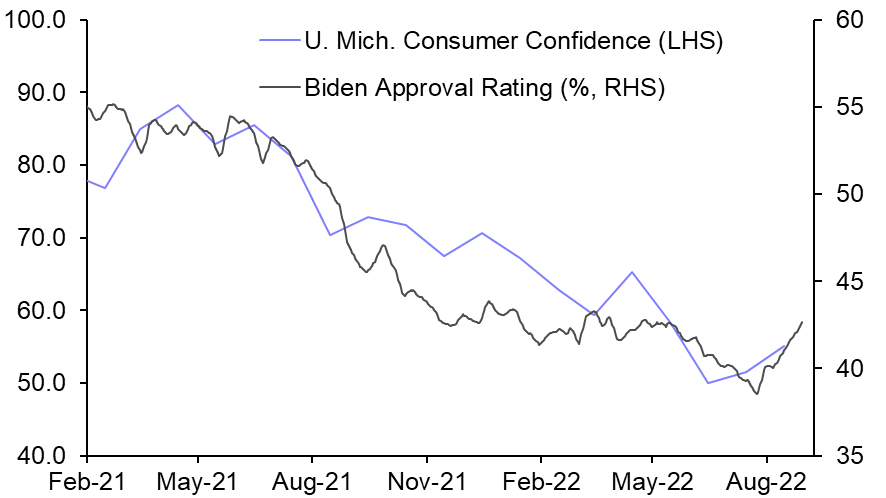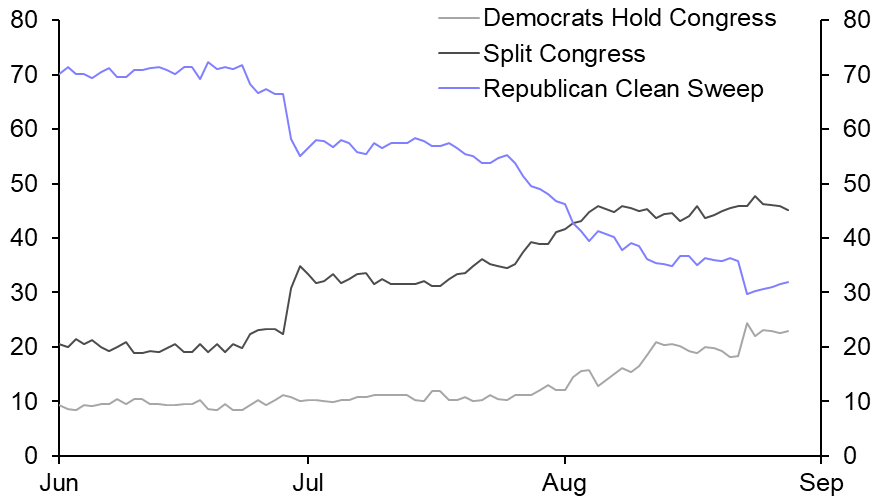- The Republican party is on track to regain control of at least the House in the upcoming midterms, though the recent narrowing in the polls means that is no longer the slam dunk it once appeared. There is a small but growing chance that Democrats retain the House and add to their majority in the Senate, which would allow them to pass additional welfare spending, funded mostly by raising taxes on higher earners.
- Republicans had been expected to overturn the Democrats’ slim majority in the House and 50-50 split in the Senate this November. In 17 of the 19 mid-term elections since World War II, the incumbent party has lost seats in the House. The surge in inflation has pushed consumer confidence (and President Biden’s approval ratings) sharply lower. (See Chart 1.) But the Supreme Court decision to overturn Roe v Wade, as well as a string of recent legislative achievements has boosted enthusiasm among Democrats, lifting their chances this November. (See Chart 2.) With falling inflation likely to provide an additional boost to their chances, a Republican victory in the mid-terms is no longer a foregone conclusion.
- If the Republicans did win back control of the House, as betting odds suggest, that would doom any major legislation, including further attempts from the Democrats to pass more of their agenda via reconciliation. Congress would still need to pass continuing resolutions or spending bills to keep the government open, as well as raise the debt limit at some point next summer. Republicans could launch their own investigations into the administration’s past actions and policies and impeach Joe Biden, although with Republicans well short of a two-thirds majority in the Senate, he would be acquitted.
- If the Democrats maintain control of both the House and Senate, much would depend on the margin of victory in the Senate. Holding onto 50 or even 51 seats would leave Senators Joe Manchin and Kyrsten Sinema with an effective veto over plans. But a bigger margin of victory would allow the Democrats to pass the welfare spending provisions scrapped from the earlier American Families Plan, including free college, universal pre-school, and a more permanent expansion to the Child Tax Credit. Much of that would be offset by increasing taxes on higher earners, and potentially also raising the corporate tax rate back up to 28% from 21%. But the bill would probably still involve a larger fiscal deficit, partially reversing the recent swing towards fiscal tightening. (See here.)
- Inevitably with the midterms, attention focuses on what it means for the next election, but those predictions are likely to be more speculative than usual this time around. By 2024 the leading candidates from both parties, Donald Trump and Joe Biden will be 78 and 81 years old respectively. Its still uncertain whether either would seek another four-year term at such an advanced age.
- Finally, it seems almost certain that results in some key battlegrounds will be contested, particularly if the results prove pivotal at the national level. Disputes would begin at the state level, but legal challenges are likely to run all the way up to the Supreme Court in a process that could take weeks to play out and generate plenty of uncertainty in the meantime. The outcome of those disputes could well end up being among the most important takeaways for the 2024 election.
|
Chart 1: Consumer Confidence & Biden Approval Rating |
Chart 2: Balance of Power After 2022 – Implied Probability from PredictIt (%) |
|
|
|
|
Sources: Refinitiv, PredictIt, FiveThirtyEight |
Michael Pearce, Senior US Economist, +1 646 934 6378, michael.pearce@capitaleconomics.com

